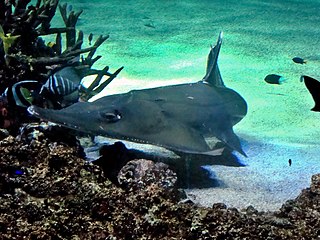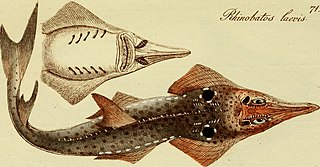
Myliobatiformes is one of the four orders of batoids, cartilaginous fishes related to sharks. They were formerly included in the order Rajiformes, but more recent phylogenetic studies have shown the myliobatiforms to be a monophyletic group, and its more derived members evolved their highly flattened shapes independently of the skates.

The guitarfish, also referred to as shovelnose rays, are a family, Rhinobatidae, of rays. The guitarfish are known for an elongated body with a flattened head and trunk and small, ray-like wings. The combined range of the various species is tropical, subtropical, and warm temperate waters worldwide.

The Gulf wobbegong or banded wobbegong is a species of carpet shark in the family Orectolobidae, found in southern Australia between Southport, Queensland and Norwegian Bay, Western Australia.

Rhina ancylostoma, the bowmouth guitarfish, shark ray or mud skate, is a species of ray and a member of the family Rhinidae. Its evolutionary affinities are not fully resolved, though it may be related to true guitarfishes and skates. This rare species occurs widely in the tropical coastal waters of the western Indo-Pacific, at depths of up to 90 m (300 ft). Highly distinctive in appearance, Rhina ancylostoma has a wide and thick body with a rounded snout and large shark-like dorsal and tail fins. Its mouth forms a W-shaped undulating line, and there are multiple thorny ridges over its head and back. It has a dorsal color pattern of many white spots over a bluish gray to brown background, with a pair of prominent black markings over the pectoral fins. This large species can reach a length of 2.7 m (8.9 ft) and weight of 135 kg (298 lb).

The giant guitarfish, also known as the whitespotted wedgefish, is a large species of guitarfish in the family Rhinidae. It is restricted to the Red Sea, Persian Gulf, and western Indian Ocean, but was formerly considered more widespread due to confusion with its relatives.

Rhynchobatus australiae, also called the white-spotted guitarfish, white-spotted wedgefish or bottlenose wedgefish, is a species of fish in the Rhinidae family. It is found from shallow waters to a depth of at least 60 m (200 ft) in the Indo-Pacific, ranging from the East African coast and the Red Sea, to Taiwan, the Philippines and Australia. It is part of a species complex that also includes the giant guitarfish, the broadnose wedgefish and possibly the smoothnose wedgefish.

Rhynchobatus is a group of rays commonly known as wedgefishes in the family Rhinidae. They are found in the tropical and subtropical Indo-Pacific with a single species in the eastern Atlantic. All species in this genus are assessed as Vulnerable or Endangered by IUCN.

The smoothnose wedgefish is a species of fish in the Rhinidae family. It is found in northern Indian Ocean and northwestern Pacific Ocean, ranging from the Arabian Sea and Persian Gulf east to Bangladesh, and South China Sea to southern Japan. Populations elsewhere are now recognized as separate species. Its natural habitat is shallow coastal seas and off the mouths of rivers. It is threatened by habitat loss and overfishing.

The African wedgefish, guitarra, Lubbert's guitarfish, or spikenose wedgefish is a species of fish in the Rhinidae family. It is the only species in its genus to occur in the East Atlantic.
The broadnose wedgefish is a species of fish in the Rhinidae family. It is found in coastal and estuarine habitats in southeast Asia, where documented from Java, Borneo, Singapore, the Philippines and Thailand. It is threatened by habitat loss and overfishing. This is a medium-sized species of Rhynchobatus, which reaches a maximum length of about 2.15 m (7.1 ft).

The whitespotted whipray or sharpnose stingray is a species of stingray in the family Dasyatidae. It is found in coastal regions including estuaries, in the Indo-Pacific, and has also been recorded in the Ganges River. It reaches a maximum disc width of 2 m (6.6 ft). As presently defined, it is probably a species complex.

Wedgefishes are rays of the family Rhinidae, comprising eleven species in three genera. Classified in the order Rhinopristiformes along with guitarfishes and sawfishes, they have also been known as giant guitarfishes or sharkfin guitarfishes.
Rhynchobatus palpebratus, the eyebrow wedgefish, is a species of fish in the Rhinidae family. It is found in coastal waters off northern Australia. It reaches up to 2.62 m (8.6 ft) in length and closely resemble the smoothnose wedgefish, which has denser white spotting, and also differ in distribution and genetics.
Peter Robert Last is an Australian ichthyologist, curator of the Australian National Fish Collection and a senior principal research scientist at CSIRO Marine and Atmospheric Research (CMAR) in Hobart, Tasmania. He is an elasmobranch expert and has described many new species of shark.

Potamotrygon falkneri, the largespot river stingray or reticulated freshwater stingray, is a species of freshwater stingray in the family Potamotrygonidae from tropical and subtropical South America. It is sometimes seen in the aquarium trade, but requires a very large tank.

Rhinopristiformes is an order of rays, cartilaginous fishes related to sharks, containing shovelnose rays and allied groups.
The false shark ray is a species of fish in the Rhinidae family and the only species in the genus Rhynchorhina. This rare ray is only known from shallow coastal Atlantic waters in Banc d’Arguin, Mauritania.
The longnose deep-sea skate is a large skate in the family Arhynchobatidae. It was first described in 1985 from specimens collected near New Zealand. It is known to be a deep-water skate, however lack of research trawls at depths past 1500 meters limits knowledge of the depths where the species can be found. The species is dark brown or grey, with an eponymous elongated snout. The species has been measured to be a maximum of 140 cm in total length, although size variation and growth patterns are not known.
Rhynchobatus immaculatus, the Taiwanese wedgefish, is a species of fish in the family Rhinidae. It is found in the Pacific Ocean in the vicinity of Taiwan. This species reaches a length of 99 cm (39 in).










